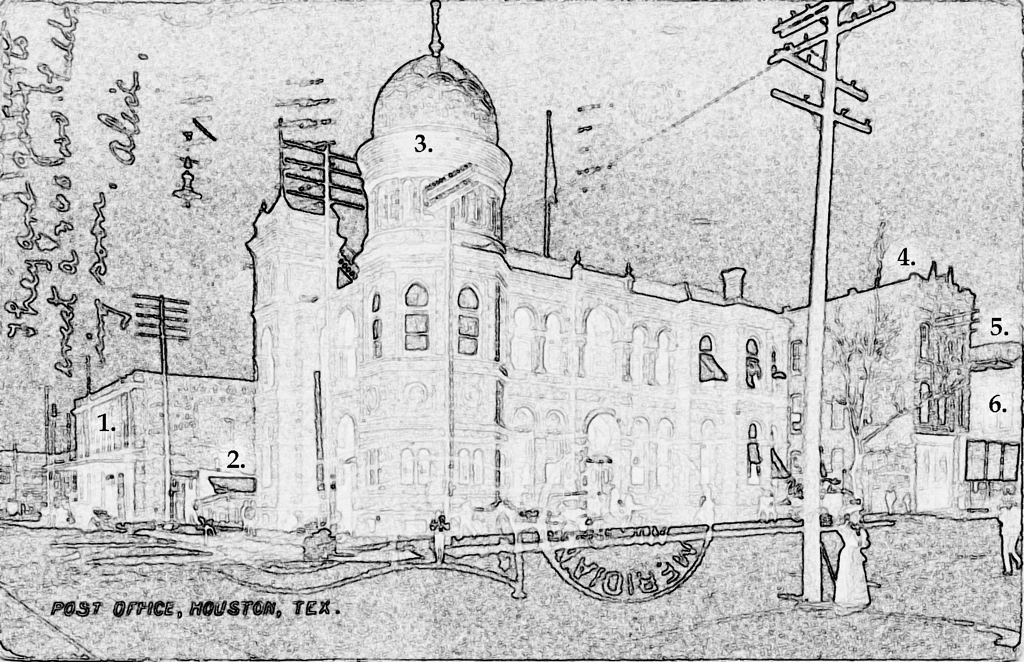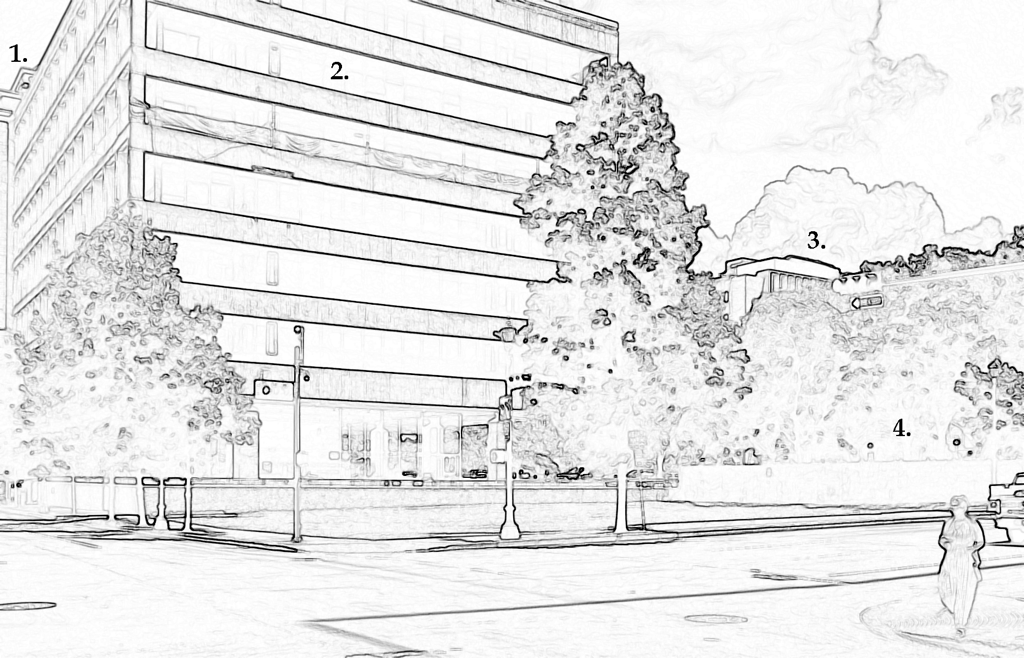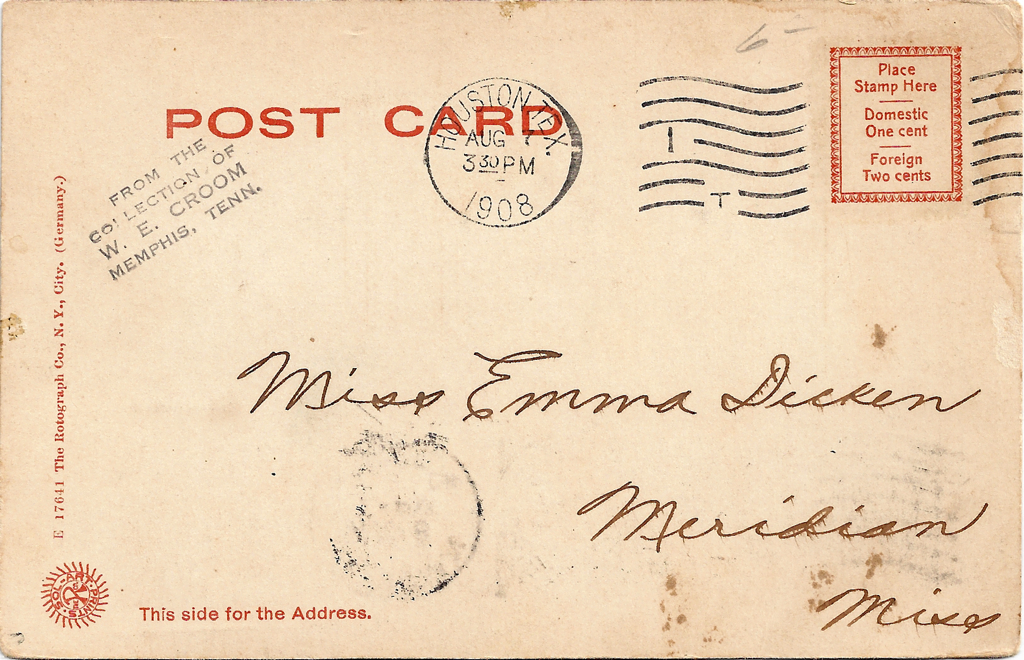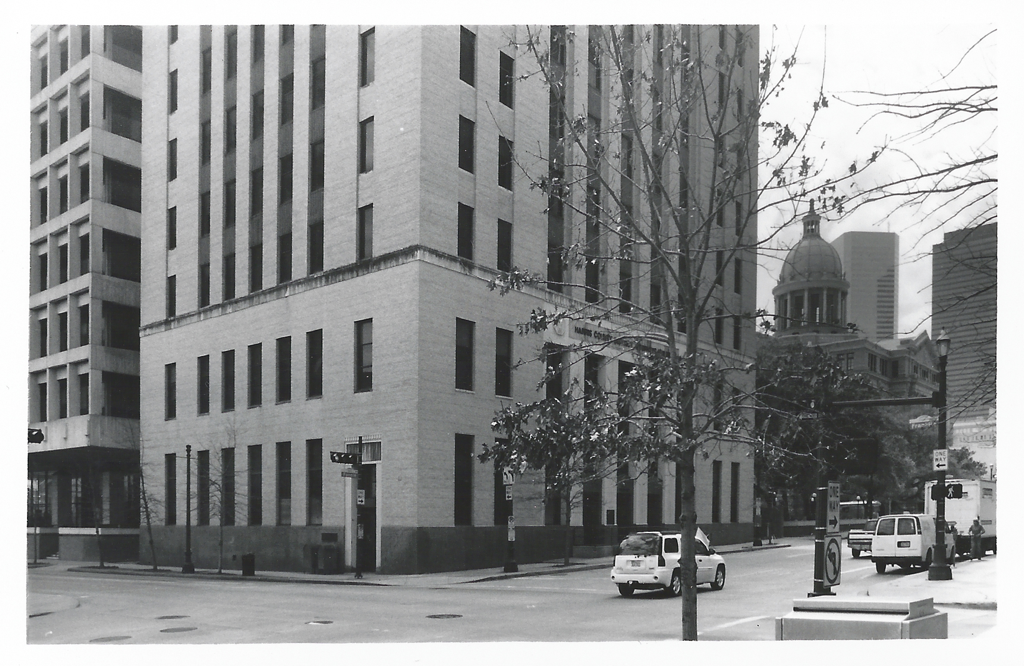Post Office
|
7 August 1908: The corner of Franklin and Fannin was one of the busiest in Houston with the post office there to draw patrons and the courthouse only a block away. The courthouse area featured many offices of lawyers, real estate agents and various other professionals. 1. 1114-1116 Franklin: Southwestern Paper Company of Dallas, wholesale paper and printers’ supplies; 2. 1110 Franklin: Schelling & Blackman, blacksmiths and horseshoers, Henry Frederick Schelling (1878-1968) and Samuel Jefferson Blackman (1879-1974); also at 1112 Franklin: A chili parlor operated by Mexican-born Antonio Espinoza (1890-1978); 3. 201 Fannin: Houston Post Office built in 1888, with railroad offices of Galveston, Harrisburg & San Antonio and Texas & New Orleans; 4. 211 Fannin: J. V. Dealy Co., Printers and Stationers, owned and managed by Jacob Valentine Dealy (1859-1974); 213-215 Fannin: The shoeshine parlor of George Chiangalakes and John F. Kousiakes; 5. 309 Fannin: The Harris County Courthouse of 1883 can be seen as a tiny blue-gray sliver representing the central tower base, which by this time had lost its central tower. Bids had already been made for construction of a new courthouse, and the old building was vacated in November 1908; 6. 1011 Congress: Latreyte’s Corner on the first floor was the saloon of Maurice T. Gombert (1867-1909), on the second floor, a U. S. Army Recruiting Station.
|
16 June 2021: After the demolition of the old post office, the Harris County District Attorney’s Bulding was erected on the site in 1939. It was still in place when early efforts to photograph the corner were undertaken (see below for a view of the building), but it was taken down in 2019. 1. 201 Caroline: Harris County Civil Justice Center, 18 floors, 2005; 2. 1115 Congress: Harris County Family Law Center, 7 floors, 1969; 3. 1200 Congress: Harris County Juvenile Justice Center and 280th District Court, 8 floors, 1951; 4. 1115 Congress: Quebedeaux Park is named in honor of Dr. Walter A. Quebedeaux (1915-1976), who spent 22 years as Harris County’s Director of Air and Water Pollution Control. Plans to turn this park into Remembrance Park seem to be on hold; the new park will commemorate four lynchings which took place in Harris County, but currently the spot is an ill-used daytime respite mostly for the homeless.
|
|
Postmarked August 7, 1908 Houston, Tex.
Received 8 August 8, 1908 Meridien, Miss. To: Miss Emma Dicken Meridian, Miss [Front] They are going to erect a $360000 building soon. Alice The Post Office Alice makes reference to was built in 1911 at 701 San Jacinto between Rusk and Capitol, now designated the Sam Houston Station.
3 March 2012: Replacing the 1888 Post Office, the District Attorney’s Building sat on the corner of Fannin and Franklin from 1929 until it was demolished in 2019. The Courthouse building seen in this view a block south was built in 1912 and is much taller than the one in service in 1908. |
Miss Emma Dicken, at the time she received this postcard in 1908, was a 35 year old clerk in the Meridian, MS post office, so no doubt her friend Alice thought she would have been interested in Houston’s post office buildings. In 1907 Houston was a city on the rise with a population of 80,000, but doubling every 10 years and the town exuded the sense of a boundless future.
Meridian, was smaller with a population of about 23,000, founded in 1860 but burned to the ground by William Tecumseh Sherman in the Battle of Meridian in 1864. In the late 19th century the town rebounded with the rise of rail traffic to become the largest city in Mississippi at the time of the postcard, but it retained a lingering legacy from the Civil War. “The War of Rebellion” as southerners preferred to call it, was conducted by Emma's ancestors. Her Uncle “Clem” (William Haslett Cleninden Black) died at Gettysburg, and most of her relatives and townsfolk were Confederates to the core. Although they were rebels in the Civl War, her family were patriots in the Revolutionary War. She qualified for DAR on three lines: Benjamin Dicken, Henry Burnley, and Thomas Cleninden. Emma herself was a genealogist, author of volumes of family history: Terrell Genealogy (1957) and Our Burnley Ancestors and allied families. Her father was James Turner Dicken, her mother Annie Black. Emma never married, living first with her father (1900, 1910), then her widowed mother (1920, 1930), then her brother Arthur (1940). She was a postal clerk from 1910 through 1930, and a writer and genealogist after retirement from the post office. Emma died 2 June 1954 at the age of 80 and is buried in Meridien. |




